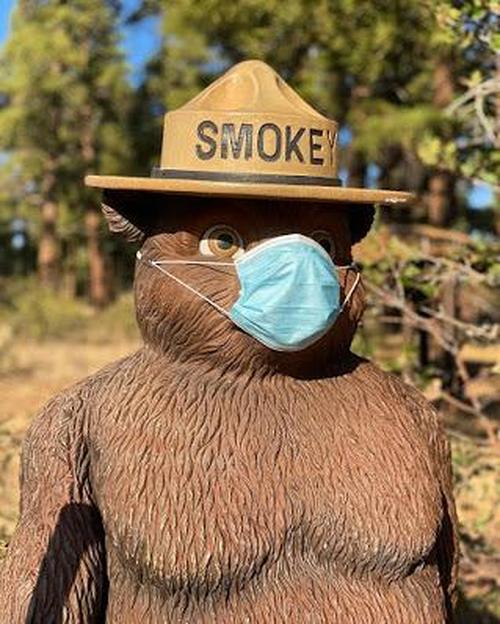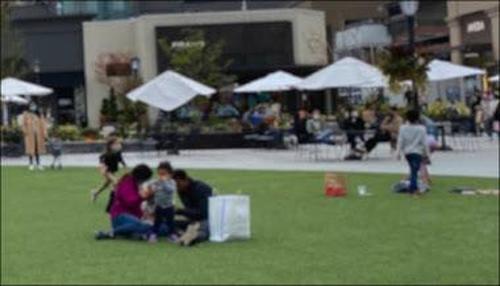Is Outside Air COVID-Safe? Are Masks Needed Outdoors?
When I visit parks in Seattle and the region, bike along the Burke Gilman Trail, cross-country ski at WA snowparks, or go hiking in the Cascades, I note that many people are wearing masks outdoors to avoid COVID-19. A lot of people.
Some folks are clearly afraid and fearful of COVID exposure outdoors. For example, I often see individuals making a point to avoid unmasked bikers or joggers on the Burke-Gilman trail…moving 5-10 feet off the trail and sometimes turning away. Occasionally it gets tense, as when one local scientist (not me) was angrily called a "Republican" when he was walking in a park without a mask.
The fear of outdoor spread even hit the management of Seattle Parks last year, when several parks and their parking lots were closed because of COVID fears.
Photo by Nate Loper Through a Creative Commons License
It is time to bring science to this issue and to relieve the worries of many who wish to enjoy outdoor recreation.
In this blog, I will tell you about measurements of carbon dioxide (CO2) I took around Seattle this weekend, measurements that suggest little threat of COVID transmission outdoors. I will also review some of the latest scientific literature, which again does not indicate a significant threat of COVID transmission in the outside air.
The message of this information is obvious: wearing masks outdoors does not appear to be necessary.
My Field Experiment Around Seattle
In my experiment, I used a sensitive CO2 sensor that makes use of proven measurement technology (see below). Human breathing puts out a lot of CO2, roughly 4 percent by volume or roughly 40,000 parts per million (ppm). The background level of CO2 in the free atmosphere is currently approximately 415 ppm…. a concentration much, much less than coming out of our mouths.
Thus, CO2 can act as a tracer of the air coming out of our respiratory systems, something mosquitoes know all about since they use the plume of CO2 we exhale to find us. By measuring CO2 levels, it is possible to determine the relative concentration of air coming from humans and the degree of dilution by the surrounding air.
There have been a number of peer-reviewed scientific papers that have shown that CO2 concentrations are a potent tool for evaluating the potential for disease spread by viruses and other agents, with higher concentrations of CO2 associated with more transmission of disease (some examples of relevant scientific papers found here and here).
Most of these papers use CO2 to measure the potential for transmission in indoor spaces, so why not take it one step further and evaluate potential disease transmission in the outside environment? That is what I did around Seattle on Saturday, a very nice day (high around 63F) with lots of people in the parks and outdoor locations.
My CO2 unit reported about 400-405 ppm away from roads and people, and this value represents the background level of carbon dioxide.
The Burke-Gilman Trail
My first stop was the crowded Burke Gilman trail, with folks walking, running, and whizzing by continuously. There was no increase in CO2 concentrations compared to the background at any time (around 400). Clearly, the diffusion/dispersion/dilution of CO2 by outside environmental air was very large. And the same would be true of any COVID virus breathed out by anyone on the trail.
Magnuson Park
I then traveled to Magnuson Park, one of the most popular parks in Seattle. First, I walked about a half-mile, back and forth, on a crowded path. No increase in CO2 values above background (still around 400 ppm).
Then I decided to really push things and walked around crowded picnic shelters, some with as many as 15-20 peoples without masks. (I suspect they thought I was being a bit odd as I circled around the groups, but this was for science!) I could find no enhancement of CO2 above the background levels….natural movement of air diffused their CO2 emissions completely. I did find a weak signal downstream of a raging barbecue fire…but even that was muted (about a 10 ppm increase 40 feet downwind).
So the bottom line so far: natural ventilation and mixing in the outside air was effective in diffusing the CO2 emitted by people in an outside park environment, even when there was a high density of people. And if CO2 enhancement by all the people was undetectable, the same would be true of COVID-19 virus emission by any infected individuals. Parks appear to be entirely safe locations and masks are not necessary.
University Village Shopping Center: Outside and Inside
Next, I went to the University Village shopping center. There is a nice little urban park adjacent to the Apple Store. It was packed with people enjoying the nice weather. If there was going to be a place where human CO2 would be evident, this would be it, particularly with nearby structures lessening the wind flow.
I walked all around the park, even close to groups of people. Only background levels of CO2 were observed. No hint of people’s CO2. Atmospheric mixing was still large, and thus there was little threat of catching COVID-19 from the general environment. And I found similar results near lines of individuals waiting to enter some U. Village stores.
Supermarkets and Indoor Restaurants
As a little side test, I then went into a busy local supermarket. The CO2 concentration zoomed up to 830 ppm. A warning, perhaps, about food stores.
Then I went into a restaurant, one that was well ventilated (I could feel the breeze) and with reasonable spacing between tables. The CO2 level was a very modest 520. Turns out the restaurant had a CO2 meter, which read 530. Good confirmation of my calibration and a positive note about the restaurant providing a safe environment for its patrons.
A Visit to A Gym
Then I stopped in a local gym, a major one located in northeast Seattle. Lots of ventilation and the CO2 level was a very modest 465. A safe place for one’s workout and less than the value in my home (which is about 530). People are required to wear masks in the gym, but quite honestly they probably aren’t needed.
Reality Check
I shared my results with some local air quality experts and a well-known epidemiologist. They thought my results were reasonable and not surprising. They acknowledged that COVID transmission is far less problematic outdoors.
One suggested that the risk outside was not zero: imagine if you had a conversation with a highly infectious individual for an extended time at close proximity (within a foot or two), with little wind and the person was upstream of you. Perhaps. But you can imagine how unlikely this situation would be. And easily avoided.
The epidemiologist, although generally agreeing about the safety of outdoor air, suggested the potential for a very short (transient) exposure to the long-distance breath of a COVID-infected person.
He noted the example of smelling cigar or pot smoke at a distance–might one get exposed to COVID the same way? I suspect this is highly unlikely. First, large virus-containing droplets tend to fall out close to the infected (that is why there is a six-foot "rule" for separation). And smaller particles tend to get diluted with distance. But just as important is that current best science suggests that extended or prolonged exposure to a COVID-infected individual is necessary, with the Centers for Disease Control indicating 30 minutes or longer (see here). That is simply not going to happen outside if you and the source are moving around.
This never made any sense and prevent people from enjoying a healthful environment
Finally, what does the current scientific literature indicate about outdoor transmission? The scientific literature is very thin on this topic, but here are some examples:
-
Qian et al., 2020: Examined 1245 confirmed cases in 120 cities in China and identified only a single outbreak in an outdoor environment, which involved two cases.
-
Nishiura et al., 2020: Transmission of COVID-19 in a closed environment was 18.7 times greater compared to an open-air environment (95% confidence interval). (they could not exclude the possibility that the few "outdoor" transmission might have occurred by undocumented indoor transmission)
-
Bulfone et al., 2021: A review of all the literature on outdoor transmission. They found only five studies, two of which are above. They noted the poor quality and inconsistent approaches of most of the studies so far.
Quite honestly, one can only be disappointed in the quality of the "studies" on outdoor transmission, which is surprising at this point in time. Importantly, there is no compelling published research that demonstrates significant outdoor transmission.
The Key Message
My observations of CO2 concentrations suggest that the diffusion, dilution, and dispersion of human exhalations are very large outdoors, making the threat of outdoor COVID-19 transmission very, very low. This is consistent with the (limited) scientific literature on the topic.
Outside air is very safe, and it gets even safer during the summer since ultraviolet radiation rapidly kills airborne virus. The logical conclusion from these results is that wearing a mask outdoors is probably unnecessary. Closing outdoor parks makes no sense at all.
If any of you see some weaknesses in the above logic, let me know. That is how science works.
Tyler Durden
Mon, 04/05/2021 – 19:00
via ZeroHedge News
Enjoy this article? Read the full version at the authors website: https://cms.zerohedge.com/



